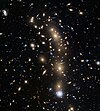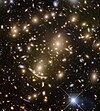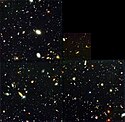Lista głębokich pól

Głębokie pole – zdjęcie fragmentu nieba wykonane z bardzo długim czasem naświetlania w celu wykrycia i zbadania słabych obiektów. Głębia pola odnosi się do pozorna wielkość gwiazdowej lub moc strumienia promieniowania najsłabszych obiektów, które można wykryć na obrazie. Obserwacje w głębokim polu zwykle obejmują niewielki obszar kątowy na niebie, ze względu na duży czas potrzebny teleskopowi na osiągnięcie obrazów słabych źródeł. Głębokie pola są używane głównie do badania ewolucji galaktyk i kosmicznej ewolucji aktywnych jąder galaktyk oraz do wykrywania słabych obiektów o dużym przesunięcie ku czerwieni. Wiele obserwatoriów naziemnych i kosmicznych prowadziło obserwacje w głębokim polu na długościach fal od radiowych do rentgenowskich.
Pierwszym obrazem głębokiego pola, który zwrócił dużą uwagę opinii publicznej, było Głębokie Pole Hubble’a, zarejestrowane w 1995 roku przez Kosmiczny Teleskop Hubble’a. Rejestrację promieniowania głębokim polu, prowadzono także przez Teleskop kosmiczny Chandra, Obserwatorium XMM-Newton oraz Kosmiczny Teleskop Spitzera.
Poniższa tabela zawiera częściową listę obserwacji w głębokim polu przeprowadzonych od 1995 roku.
| Obraz | Nazwa | Rok rejestracji | Liczba ekspozycji |
|---|---|---|---|
 | Głębokie Pole Hubble’a | 1995 | 342 |
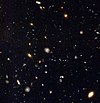 | Głębokie Południowe Pole Hubble’a | 1998 | 995 |
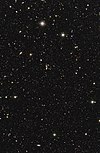 | Głębokie Południowe Pole Chandry | 1999–2000 | 11 |
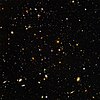 | Ultragłębokie Pole Hubble’a | 2003–2004 | 808 |
| Extended Groth Strip | 2004–2005 | ponad 500 | |
 | Cosmic Assembly Near-infrared Deep Extragalactic Legacy Survey (CANDELS) | 2011 | |
 | ESO’s VLT i SINFONI instrument[2] | 2012 | |
 | Ekstremalnie Głębokie Pole Hubble’a | 2012 | |
 | Ultragłębokie Pole Hubble’a (UV/VIS/NIR) | 2014 | |
(c) ESA/Hubble, CC BY 4.0 | Frontier Fields MACS J0416.1-2403[3] | 2015 | |
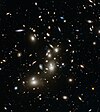 | Frontier Fields Abell 2744[4] | 2015 | |
 | Frontier Fields MACS J0717.5+3745 | 2015 | |
(c) ESA/Hubble, CC BY 4.0 | Frontier Fields MACS J1149.5+2223[5] | 2015 | |
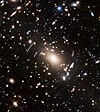 | Frontier Fields Abell S1063[6] | 2016 | |
(c) ESA/Hubble, CC BY 4.0 | Frontier Fields Abell 370[7] | 2017 | |
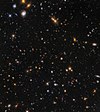 | Frontier Fields Abell 370 parallel field[8] | 2017 | |
 | Hubble Deep UV (HDUV) Legacy Survey[9] | 2018 | |
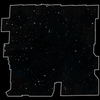 | Pole dziedzictwo Hubble’a[1] | 2019 | 7500 |
 | Webb’s First Deep Field[10] | 2022 |
Przypisy
- ↑ a b Hubble Assembles Wide View of the Distant Universe, www.spacetelescope.org [dostęp 2022-05-22] (ang.).
- ↑ The Feeding Habits of Teenage Galaxies, www.eso.org [dostęp 2022-05-22] (ang.).
- ↑ MACS J0416 Data is Complete, Frontier Fields, 21 stycznia 2015 [dostęp 2022-05-22] (ang.).
- ↑ Meet the Frontier Fields: Abell 2744, Frontier Fields, 4 lutego 2014 [dostęp 2022-05-22] (ang.).
- ↑ A galactic gathering, www.spacetelescope.org [dostęp 2022-05-22] (ang.).
- ↑ Space... the final frontier, www.spacetelescope.org [dostęp 2022-05-22] (ang.).
- ↑ The last of the Frontier Fields — Abell 370, www.spacetelescope.org [dostęp 2022-05-22] (ang.).
- ↑ Abell 370 parallel field, www.spacetelescope.org [dostęp 2022-05-22] (ang.).
- ↑ Karl Hille, Hubble Paints Picture of the Evolving Universe, NASA, 15 sierpnia 2018 [dostęp 2022-05-22].
- ↑ Rob Garner: NASA's Webb Delivers Deepest Infrared Image of Universe Yet (ang.). NASA, 2022-07-11. [dostęp 2022-07-12]. [zarchiwizowane z tego adresu (2022-07-11)].
Media użyte na tej stronie
(c) ESA/Hubble, CC BY 4.0
Nearly as deep as the Hubble Ultra Deep Field, which contains approximately 10 000 galaxies, this incredible image from the NASA/ESA Space Telescope reveals thousands of colourful galaxies in the constellation of Leo (The Lion). This vibrant view of the early Universe was captured as part of the Frontier Fields campaign, which aims to investigate galaxy clusters in more detail than ever before, and to explore some of the most distant galaxies in the Universe.
Galaxy clusters are massive. They can have a tremendous impact on their surroundings, with their immense gravity warping and amplifying the light from more distant objects. This phenomenon, known as gravitational lensing, can help astronomers to see galaxies that would otherwise be too faint, aiding our hunt for residents of the primordial Universe.
MACS J1149.5+2223 is a galaxy cluster located approximately five billion light-years away. In 2012, it helped astronomers uncover one of the most distant galaxies ever discovered. Light from the young galaxy, magnified 15 times by the galaxy cluster, first shone when our 13.7-billion-year-old Universe was a mere 500 million years old — just 3.6 per cent of its current age!
In 2014 and 2015, MACS J1149.5+2223 was observed as part of the Frontier Fields campaign. While one of Hubble’s cameras observed the galaxy cluster itself, another simultaneously captured the spectacular scene pictured above, of an “unremarkable” patch of space. Referred to as a parallel field, this image — when compared to other similar fields — will help astronomers understand how the Universe looks in different directions.Abell S1063, a galaxy cluster, was observed by the NASA/ESA Hubble Space Telescope as part of the Frontier Fields programme. The huge mass of the cluster acts as a cosmic magnifying glass and enlarges even more distant galaxies, so they become bright enough for Hubble to see - more details on https://sci.esa.int/web/hubble/-/58092-space-the-final-frontier-heic1615
Several hundred images taken with NASA's Hubble Space Telescope have been woven together into a rich tapestry of at least 50,000 galaxies, called the Extended Groth Strip. The Hubble view is yielding new clues about the universe's youth, from its "pre-teen" years to young adulthood.
The snowstorm of galaxies in the Hubble panorama does not appear evenly spread out. Some galaxies seem to be grouped together. Others are scattered through space. This uneven distribution of galaxies traces the concentration of dark matter, an invisible web-like structure stretching throughout space. Galaxies form in areas rich in dark matter.
Among the discoveries so far in this galactic tapestry are a giant red galaxy with two black holes at its core; several new gravitational lenses - galaxies whose gravity bends the light from background galaxies into multiple images; and a rogues' gallery of weird galaxies that should keep astronomers busy for a long time trying to explain them.
Hubble's wide view - achieved by weaving together many separate exposures into a mosaic - still only covers a comparatively small slice of sky. The entire width of the image, in angular size, is no bigger on the sky than the apparent width of your finger held at arm's length. To astronomers, however, this seemingly small area is a big piece of celestial real estate.
To cover even this much of the sky, Hubble's Advanced Camera for Surveys snapped more than 500 separate exposures, at 63 different pointings, spread out over the course of one year. The final mosaic is 21 images long by 3 images tall. (The dimensions in degrees are about 1.1 by 0.15 degrees. For comparison, the Moon is about 0.5 degrees in angular size).
The Extended Groth Strip is named for Princeton University physicist Edward Groth. The project is jointly led by Sandra Faber, professor of physics and astronomy at the University of California at Santa Cruz, and Marc Davis, professor of astronomy at the University of California at Berkeley.The Hubble Deep Field, a picture taken over the course of ten consecutive days in December 1995, by the Hubble Space Telescope.
The Hubble Ultra Deep Field, is an image of a small region of space in the constellation Fornax, composited from Hubble Space Telescope data accumulated over a period from September 3, 2003 through January 16, 2004. The patch of sky in which the galaxies reside was chosen because it had a low density of bright stars in the near-field.
This image from the NASA/ESA Hubble Space Telescope shows the galaxy cluster MACSJ0717.5+3745. This is one of six being studied by the Hubble Frontier Fields programme, which together have produced the deepest images of gravitational lensing ever made. Due to the huge mass of the cluster it is bending the light of background objects, acting as a magnifying lens. It is one of the most massive galaxy clusters known, and it is also the largest known gravitational lens. Of all of the galaxy clusters known and measured, MACS J0717 lenses the largest area of the sky.
Abell 370 parallel field taken by the Hubble Space Telescope
STScI-2019-17 Hubble Legacy Field. The dimensions of this image at full resolution are 25,500 x 25,500 pixels, and the file size is 672 megabytes.
Extracts from accompanying press release:
Hubble Astronomers Assemble Wide View of the Evolving Universe
Astronomers have put together the largest and most comprehensive "history book" of galaxies into one single image, using 16 years' worth of observations from NASA's Hubble Space Telescope.
The deep-sky mosaic, created from nearly 7,500 individual exposures, provides a wide portrait of the distant universe, containing 265,000 galaxies that stretch back through 13.3 billion years of time to just 500 million years after the big bang. The faintest and farthest galaxies are just one ten-billionth the brightness of what the human eye can see.
This ambitious endeavor, called the Hubble Legacy Field, also combines observations taken by several Hubble deep-field surveys, including the eXtreme Deep Field (XDF), the deepest view of the universe. The wavelength range stretches from ultraviolet to near-infrared light, capturing the key features of galaxy assembly over time.
This wider view contains about 30 times as many galaxies as in the previous deep fields. The new portrait, a mosaic of multiple snapshots, covers almost the width of the full Moon.
Assembling all of the observations was an immense task. The image comprises the collective work of 31 Hubble programs by different teams of astronomers. Hubble has spent more time on this tiny area than on any other region of the sky, totaling more than 250 days, representing nearly three-quarters of a year.
This new image mosaic is the first in a series of Hubble Legacy Field images. The team is working on a second set of images, totaling more than 5,200 Hubble exposures, in another area of the sky. In the future, astronomers hope to broaden the multiwavelength range in the legacy images to include longer-wavelength infrared data and high-energy X-ray observations from two other NASA Great Observatories, the Spitzer Space Telescope and Chandra X-ray Observatory.Hubble Frontier Fields view of Abell 2744
http://www.spacetelescope.org/images/heic1401a/
This image of Abell 2744 is the first to come from Hubble's Frontier Fields observing programme, which is using the magnifying power of enormous galaxy clusters to peer deep into the distant Universe. Abell 2744, nicknamed Pandora's Cluster, is thought to have a very violent history, having formed from a cosmic pile-up of multiple galaxy clusters.
Abell 2744 is the first of six targets for an observing programme known as Frontier Fields. This three-year, 840-orbit programme will yield our deepest views of the Universe to date, using the power of Hubble to explore more distant regions of space than could otherwise be seen, by observing gravitational lensing effects around six different galaxy clusters.(c) ESA/Hubble, CC BY 4.0
With the final observation of the distant galaxy cluster Abell 370 — some five billion light-years away — the Frontier Fields program came to an end. Abell 370 is one of the very first galaxy clusters in which astronomers observed the phenomenon of gravitational lensing, the warping of spacetime by the cluster’s gravitational field that distorts the light from galaxies lying far behind it. This manifests as arcs and streaks in the picture, which are the stretched images of background galaxies.
Astronomers have just assembled one of the most comprehensive portraits yet of the universe’s evolutionary history, based on a broad spectrum of observations by the Hubble Space Telescope and other space and ground-based telescopes. In particular, Hubble’s ultraviolet vision opens a new window on the evolving universe, tracking the birth of stars over the last 11 billion years back to the cosmos’ busiest star-forming period, about 3 billion years after the big bang. This photo encompasses a sea of approximately 15,000 galaxies — 12,000 of which are star-forming — widely distributed in time and space. This mosaic is 14 times the area of the Hubble Ultra Violet Ultra Deep Field released in 2014.
The image straddles the gap between the very distant galaxies, which can only be viewed in infrared light, and closer galaxies, which can be seen across a broad spectrum. The light from distant star-forming regions in remote galaxies started out as ultraviolet. However, the expansion of the universe has shifted the light into infrared wavelengths. By comparing images of star formation in the distant and nearby universe, astronomers glean a better understanding of how nearby galaxies grew from small clumps of hot, young stars long ago.
Because Earth’s atmosphere filters most ultraviolet light, Hubble can provide some of the most sensitive space-based ultraviolet observations possible.
The program, called the Hubble Deep UV (HDUV) Legacy Survey, extends and builds on the previous Hubble multi-wavelength data in the CANDELS-Deep (Cosmic Assembly Near-infrared Deep Extragalactic Legacy Survey) fields within the central part of the GOODS (Great Observatories Origins Deep Survey) fields. This mosaic is 14 times the area of the Hubble Ultra Violet Ultra Deep Field released in 2014.
This image is a portion of the GOODS-North field, which is located in the northern constellation Ursa Major.NASA’s James Webb Space Telescope has produced the deepest and sharpest infrared image of the distant universe to date. Known as Webb’s First Deep Field, this image of galaxy cluster SMACS 0723 is overflowing with detail.
Thousands of galaxies – including the faintest objects ever observed in the infrared – have appeared in Webb’s view for the first time. This slice of the vast universe covers a patch of sky approximately the size of a grain of sand held at arm’s length by someone on the ground.
This deep field, taken by Webb’s Near-Infrared Camera (NIRCam), is a composite made from images at different wavelengths, totaling 12.5 hours – achieving depths at infrared wavelengths beyond the Hubble Space Telescope’s deepest fields, which took weeks.
The image shows the galaxy cluster SMACS 0723 as it appeared 4.6 billion years ago. The combined mass of this galaxy cluster acts as a gravitational lens, magnifying much more distant galaxies behind it. Webb’s NIRCam has brought those distant galaxies into sharp focus – they have tiny, faint structures that have never been seen before, including star clusters and diffuse features.Hubble Extreme Deep Field image (full resolution). Exposure dates: July 2002 to March 2012[3], with main contributions from 2002–2003 (visible) and 2009 (infrared)[4]. Image released by NASA on September 25th, 2012.
(c) ESA/Hubble, CC BY 4.0
This image from the NASA/ESA Hubble Space Telescope shows the galaxy cluster MACS J0416.1–2403. This is one of six being studied by the Hubble Frontier Fields programme, which together have produced the deepest images of gravitational lensing ever made. Due to the huge mass of the cluster it is bending the light of background objects, acting as a magnifying lens. Astronomers used this and two other clusters to find galaxies which existed only 600 to 900 million years after the Big Bang.
The Hubble Deep Field South.
The Chandra Deep Field South, observed in the U-, B-, and R-bands with ESO's VIMOS and WFI instruments. The U-band VIMOS observations were made over a period of 40 hours and constitute the deepest image ever taken from the ground in the U-band. The image covers a region of 14.1 x 21.6 arcmin on the sky and shows galaxies that are 1 billion times fainter than can be seen by the unaided eye. The VIMOS R-band image was assembled by the ESO/GOODS team from archival data, while the WFI B-band image was produced by the GABODS team.
June 3, 2014
RELEASE 14-151
Hubble Team Unveils Most Colorful View of Universe Captured by Space Telescope
http://hubblesite.org/newscenter/archive/releases/2014/27
Composite image showing the visible and near infrared light spectrum This is a composite image showing the visible and near infrared light spectrum collected from Hubble's ACS and WFC3 instruments over a nine-year period.
Astronomers using NASA's Hubble Space Telescope have assembled a comprehensive picture of the evolving universe – among the most colorful deep space images ever captured by the 24-year-old telescope.
Researchers say the image, in new study called the Ultraviolet Coverage of the Hubble Ultra Deep Field, provides the missing link in star formation. The Hubble Ultra Deep Field 2014 image is a composite of separate exposures taken in 2003 to 2012 with Hubble's Advanced Camera for Surveys and Wide Field Camera 3. Astronomers previously studied the Hubble Ultra Deep Field (HUDF) in visible and near-infrared light in a series of images captured from 2003 to 2009. The HUDF shows a small section of space in the southern-hemisphere constellation Fornax. Now, using ultraviolet light, astronomers have combined the full range of colors available to Hubble, stretching all the way from ultraviolet to near-infrared light. The resulting image -- made from 841 orbits of telescope viewing time -- contains approximately 10,000 galaxies, extending back in time to within a few hundred million years of the big bang.
Prior to the Ultraviolet Coverage of the Hubble Ultra Deep Field study of the universe, astronomers were in a curious position. Missions such as NASA's Galaxy Evolution Explorer (GALEX) observatory, which operated from 2003 to 2013, provided significant knowledge of star formation in nearby galaxies. Using Hubble's near-infrared capability, researchers also studied star birth in the most distant galaxies, which appear to us in their most primitive stages due to the significant amount of time required for the light of distant stars to travel into a visible range. But for the period in between, when most of the stars in the universe were born -- a distance extending from about 5 to 10 billion light-years -- they did not have enough data.
"The lack of information from ultraviolet light made studying galaxies in the HUDF like trying to understand the history of families without knowing about the grade-school children," said principal investigator Harry Teplitz of Caltech in Pasadena, California. "The addition of the ultraviolet fills in this missing range."
Ultraviolet light comes from the hottest, largest and youngest stars. By observing at these wavelengths, researchers get a direct look at which galaxies are forming stars and where the stars are forming within those galaxies.
Studying the ultraviolet images of galaxies in this intermediate time period enables astronomers to understand how galaxies grew in size by forming small collections of very hot stars. Because Earth's atmosphere filters most ultraviolet light, this work can only be accomplished with a space-based telescope.
"Ultraviolet surveys like this one using the unique capability of Hubble are incredibly important in planning for NASA's James Webb Space Telescope," said team member Dr. Rogier Windhorst of Arizona State University in Tempe. "Hubble provides an invaluable ultraviolet light dataset that researchers will need to combine with infrared data from Webb. This is the first really deep ultraviolet image to show the power of that combination."
The Hubble Space Telescope is a project of international cooperation between NASA and the European Space Agency. NASA's Goddard Space Flight Center in Greenbelt, Maryland, manages the telescope. The Space Telescope Science Institute (STScI) in Baltimore conducts Hubble science operations. STScI is operated for NASA by the Association of Universities for Research in Astronomy, Inc., in Washington.
For Hubble Ultra Deep Field 2014 images and more information about Hubble, visit:
http://hubblesite.org/news/2014/27 and http://www.nasa.gov/hubbleThe Hubble Space Telescope as seen from the departing Space Shuttle Atlantis, flying STS-125, HST Servicing Mission 4.
This is a montage of four small, young galaxies taken from a Hubble Space Telescope Wide Field Camera 3 slitless grism sample of 28 low-mass galaxies located 10 billion light-years away in the Hubble Ultra Deep Field region of the Cosmic Assembly Near-infrared Deep Extragalactic Legacy Survey (CANDELS). These colour images were generated from exposures in six different Hubble filters and provide detailed information about the different wavelengths of light coming from the galaxies. Astronomers say this new study gives them a view of galaxies as they appeared when the Universe was less than a quarter of its current age and shows that central black holes formed at an early stage in galaxy evolution.
Autor: ESA, Licencja: CC BY-SA 4.0
Comparison of how far in the past some of the Hubble space telescope deep fields have seen in terms of redshift and also how far should the future James Webb space telescope be able to see when in operation.
Autor: ESO/CFHT, Licencja: CC BY 3.0
This deep view of a tiny patch of sky in the constellation of Cetus (The Sea Monster) shows a selection of galaxies, marked with red crosses, that were used in a new survey of the feeding habits of young galaxies as they grew through cosmic time. Each of the tiny blobs, galaxies seen as they were between three and five billion years after the Big Bang, has been studied in detail using ESO’s VLT and the SINFONI instrument.

